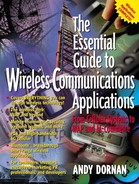Chapter 3. Cellular Networks
In this chapter…
The American mobile industry is full of hype about PCS (Personal Communications Services) technology, as opposed to cellular. The latter is often used as a pejorative term, representing the older analog phones still popular in many parts of the world, including the United States. But in truth, nearly all mobile systems are cellular—they rely on a network of cells, with a powerful radio transceiver at the center of each. The basic design of a cellular network remains the same, whether it is used for second-generation PCS or even third-generation multimedia.
There has traditionally been a distinction between cellular and PMR (Private Mobile Radio) networks. Take a look at Figure 3.1 to see the difference. PMR networks either rely on direct handset-to-handset communication (like a walkie-talkie) or use a single base station. Cellular networks use many base stations, allowing them to cover a much wider area. The base stations are usually connected to each other using fiber-optic cables or high point-to-point wireless links, then to external networks such as the phone system and the Internet.
Cellular networks have proved so successful that this distinction is now blurring. Former users of PMR, such as the emergency services, have started to adopt cellular technology, while private networks have also begun to use hybrid technologies. These do use cells, but add features such as direct links between handsets so that they can be used outside of their coverage area.
Figure 3.1. Types of mobile radio

